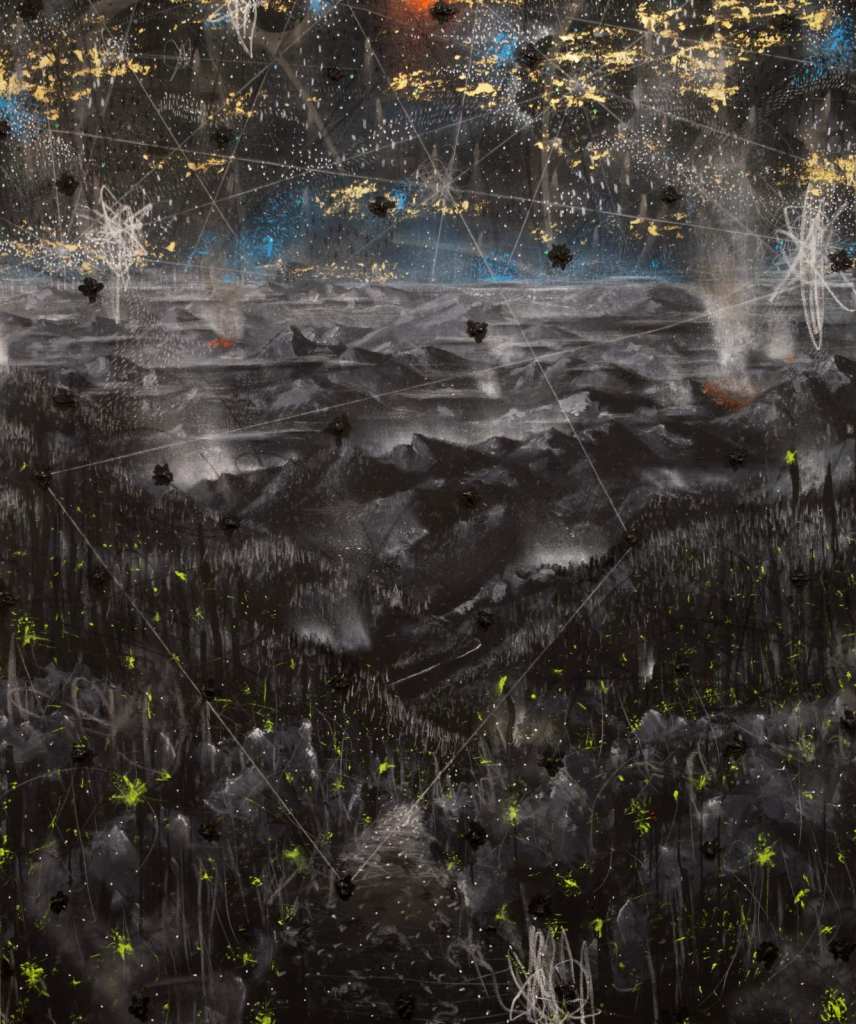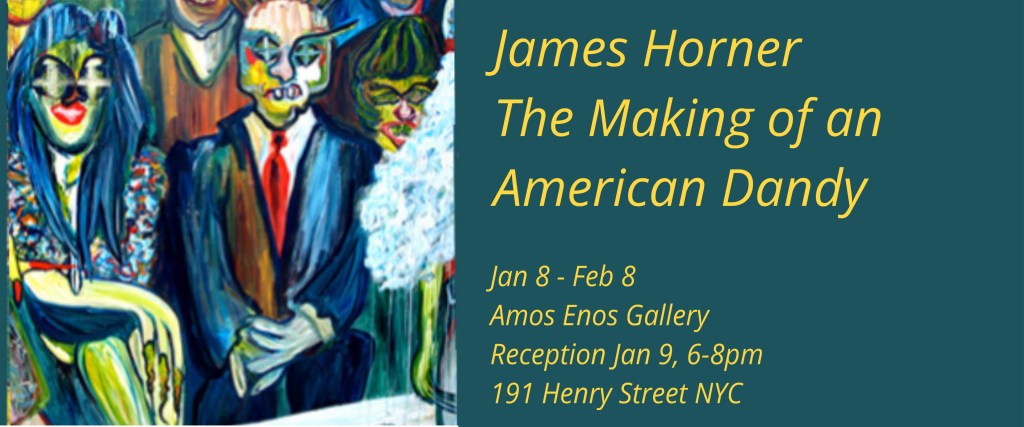
Contributed by Jenny Zoe Casey / In a fascinating and inspired pairing, “The Burden of Wait” at Susan Inglett brings together painters Michi Meko and Jodi Hays and explores the different ways in which inhabitants of a particular region – here the American South – can experience it. Landscape is an important influence for both artists, but their approaches are mostly in opposition. Meko works with blacks to create nightscapes, while Hays uses daytime colors. Meko employs perspective to suggest panoramic vistas, whereas Hays’s work is largely flat. Meko’s deep, psychological spaces have a sci-fi vibe; in Hays’s work real-world materials – reclaimed paper, textiles, and cardboard, sometimes with labeling – are recognizable.
NOTE: Two Coats of Paint 2022 Fundraising Campaign is underway. If you enjoy Two Coats of Paint’s art coverage, please consider making a tax-deductible contribution. Help keep the painting conversation going in 2023. Thank you! Click here to contribute.

Meko’s extravagantly titled FogLand: Within the Barren Valley of The Black Monoliths. The Narrow Path Through Our Bullshit. Woosah Muthafucka Woosah is the exhibition’s largest painting, and it sets a serious tone. A commanding shape resembling a massive burnt-out tree trunk, just right of center, seems to issue a warning. It is flanked by similar shapes posted along a receding horizon, perhaps guardians of a sort. The bottom quarter of the image is dense with what look like stumps, trees killed and cut notionally rendering the near ground impassable. To the left, on slightly smoother ground where the referenced narrow path could be, is an analogous shape that could be a person. The portion of the image that refers to natural features of the earth – ground, a dead forest – is very still. The action is in the sky, where hints of white and gold conjure a world full of motion and reflected light, tangles of incandescence appearing like lanterns. Crisscrossed with linear elements suggesting nautical charts, this atmospheric activity suggests the possibility of solace and hope.

His vertically oriented In tandem with the whole existence: Never Separate likewise communicates vitality. In the bottom half of the painting, plants with radial, feathered branches throw pink light at each other, their trunks dipped in lapping pools. Above is another light-filled vault, with a knotted sun of fluorescing orange at its apex, spreading its rays like a beacon to map the territory. Directional lines also feature in Keloid Constellations: Judgments from a high perch. A scarred landscape,but in this painting defining a dystopian mountainscape. A path is bounded on either side by dark grass splashed with eerie emanations. The viewer looks out over difficult terrain that stretches far into the distance. Strange blue wisps and levitating black orbs menace the stars and gold of the night sky. The mood of Wading Fugitive. “Its not about the fish, but the water” – Artist John Gill is similarly dark. Instead of directional lines, curvilinear ones that look like stitches or footprints cross the sky, whose signature gold formations are marred by blue splotches and white scribbles. Patterns, dark lines, dots, gray spheres, black holes, x’s and mysterious lights inhabit the space. A faint glow rims the horizon. The way forward appears to be through a swamp.

Meko is a maximalist who uses intriguing materials with uninhibited panache. Oil pastel, colored pencil, gouache, gold leaf, fishing line, fly-line backing, black pompoms, hologram glitter, and sequins embellish his rich surfaces. Hays, by contrast, has a bare-bones aesthetic. In May/December she evokes the temperate greens of burgeoning spring and the chill grays and whites of winter using only cardboard treated with dye, one of the cheapest methods of transformation available. The painting reads as an aerial view of green spaces, buildings, and a body of water. The placement of color suggests the passing of seasons. In Meridian, she presents a landscape of greens and grays, composed to resemble farmland seen from an airplane. She extends her plane beyond the painting’s frame at the top right and at the lower right. In some places, the corrugation of the cardboard, dyed green, resembles rows of crops. The title, referring to a circle of constant longitude, suggests movement across time and space.

Both artists riff on the limitations of the grid, but in alternative ways. Meko’s grid consists of rotated, irregular angles and off-kilter quadrilaterals and serves as a kind of functional wayfinding instrument that is at odds with modernist purity. While Hays offers gentle resistance to the canon in her use of castoff consumables, the grid is firmly present in her work by virtue of faithfulness to the box, the rhythms of her collage, and her geometry. But she does employ tears and the occasional break from the frame to loosen the grid’s hold. In Sweet one, the smallest piece in the show, Hays refers to the grid by way of checked fabric. A transparent dark blue shape with scalloped edges rests over stretched red gingham. Like a parted curtain, a small triangular opening in the blue reveals unadorned material. Thus, with the most minimal means, Hays evokes the iconic rural kitchen.

24 x 30 inches
Cotton, which is placed directly across from Meko’s FogLand, is Hays’s largest piece in the show. It is made primarily of dyed, collaged cardboard. In the top third or so, pink and white diagonal stripes bring to mind caution signs or candy stripes. Several incomplete labels suggest that these repurposed boxes originally held “grapes that really do taste like candy.” Below the stripes, pale blues washed out to white, like bleached-out denim, dominate. Other partial branding suggests a homely life of mundane Amazon or big-box shopping. The overall impression is of a spartan daily routine that is neither easy nor joyless.

Acrylic on stretched fabric, 8 x 8 1/2 inches

71 x 56 inches
In reusing everyday materials found in her immediate environment, Hays locates resilience in history, memory, and the enduring stability of domestic life. Meko, placing the viewer at the center of forbidding panoramic visions, seems to turn towards the future, putting his faith in will and imagination. Both artists develop their visions with skill, authority, and heart, and neither outlook seems expendable.
“The Burden of Wait: Paintings from the New American South,” Susan Inglett Gallery, 522 W. 24th Street, New York, NY. Through January 28, 2023.
About the author: Jenny Zoe Casey is a Chicago-based painter and art writer.
Help keep the painting conversation going in 2023. Thank you! Click here to contribute.






















